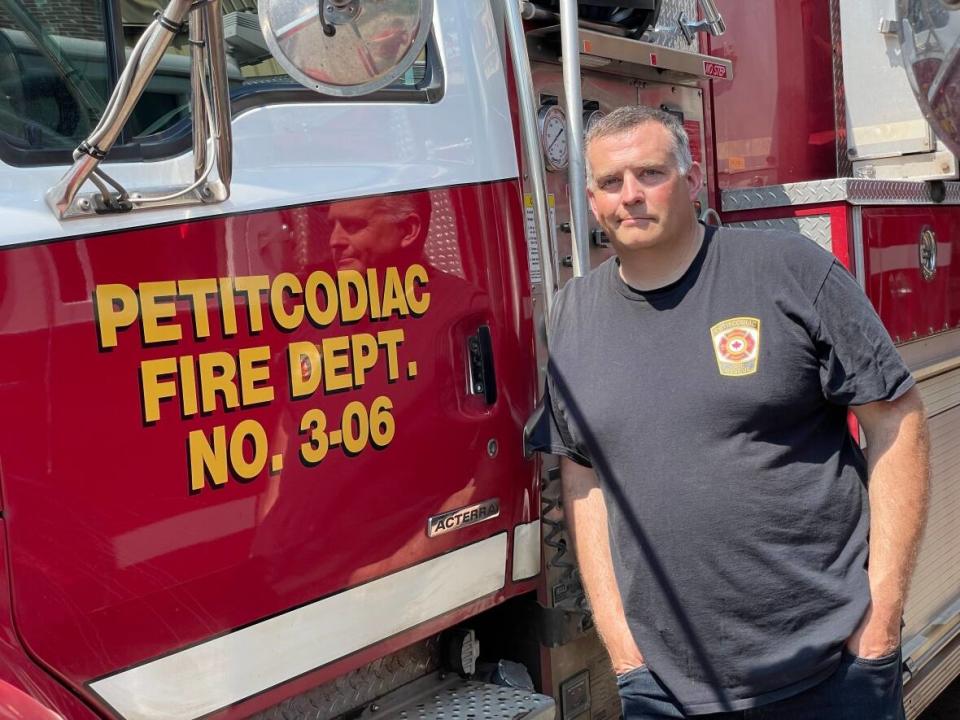
At the Petitcodiac fire station, Chief Craig Ramsey worries he might be short of firefighters for the next emergency call. Most daytime hours, only three-to-five volunteers are typically available.
“It’s extremely concerning,” he said. “From time-to-time we have excellent coverage and there’s times we have very poor coverage.”
Petitcodiac is one of a growing number of communities in New Brunswick and across Canada struggling to find enough volunteers to keep residents safe.
While cities employ career firefighters, small towns and villages rely on volunteers.

Out of the more than 5,000 firefighters in the province, about 95 per cent are volunteers, according to the New Brunswick Association of Fire Chiefs.
Petitcodiac’s station currently has 23 volunteers, but Ramsey said the department needs at least five more.
In the small community around 42 kilometres southwest of Moncton, many residents once worked at a large sawmill. But after the operation closed, most now drive to work in the city. At times, that leaves as few as two volunteers to respond to an emergency, forcing a reliance on mutual aid from surrounding communities.
24-7 commitment
Peter Saunders is mayor of the newly amalgamated village of Three Rivers, which includes Petitcodiac. He’s been a volunteer firefighter for more than 30 years and previously served as chief.
Saunders, 61, works at a building supplies store in the village of 1,400 people, where he keeps his radio on to monitor for calls. Being a volunteer firefighter is a 24-7 role and is disruptive to family, home and work life.
“One minute you’re washing dishes, the next minute you’re at the end of a hose line or you’re driving a truck,” Saunders said.
WATCH | Volunteer firefighters rush to an emergency call:
Despite working dangerous situations, most volunteers only receive a few hundred dollars a year to cover their mileage. If they reach enough hours, they are also eligible to claim a $3,000 federal tax credit.
It’s also a big time commitment just to get started. It takes 100 hours to do the basic course to become a volunteer firefighter in New Brunswick. Most members also have to commit to regular training one-to-two-nights a week, in addition to responding to calls.
Saunders’s father was a volunteer first responder with St. John Ambulance, which encouraged his involvement. But he’s seen interest decline over his time with the fire department.
“I believe that we do make a difference, even though there are bad situations. It’s the helping people and to have them comfortable in the toughest situations,” he said.
Recruitment challenges
The New Brunswick Association of Fire Chiefs doesn’t have exact numbers on the shortage, but president Scott Poupart, a volunteer firefighter near Bathurst, estimates most volunteer departments need an additional six to 12 firefighters on their rosters.
“We’re all in a continual recruitment and retention mode,” he said.
Canada lost 30,000 firefighters over the past six years, according to a national survey.
Most firefighters in New Brunswick are over the age of 50, and many long-serving volunteers are expected to retire in the coming years.
Ramsey, who has been a firefighter for 20 years, attributes the recruitment struggles to several factors, including changing family dynamics and a decline in volunteerism in general.
Another challenge is that the responsibilities of a firefighter have greatly expanded beyond fires. Calls now include car accidents, medical calls, off-road rescues, overdoses and forest fires. The varying incidents require more specialized training.
The number of calls is now on the rise, with Petitcodiac firefighters responding to more than 150, on average, per year.
Since Saunders started, he said the types of emergencies firefighters respond to and provincial regulations have all expanded. Some calls can be traumatic, including grim car accidents, he said.
“You’re asking for a lot for someone to be a volunteer today in the fire department business. For a thank you, for a handshake, for that barbecue. It’s a lot,” he said.
Possible solutions
As the number of volunteer firefighters decline, some departments are starting to pay members per call or hiring full-time chiefs — substantial costs for rural communities already footing the bill for expensive firefighting equipment. Others are hiring a few career firefighters to supplement the volunteers.

Saunders suggests one solution could be recruiting volunteers in whatever capacity they’re willing to lend a hand.
“Maybe there’s some people who don’t want to go near car accidents, or maybe there’s some people who don’t want to wear an air pack. That’s fine, but I’m telling you there’s a job for you somewhere that you’re going to be comfortable with,” he said.
Firefighter associations are also lobbying the federal government to increase the volunteer tax credit to $10,000 from $3,000 per year.
Poupart said while the field is dangerous, there are ways to make it more appealing and accessible.
“We need to draw that new blood into the fire service, and the only way we’re going to do that is by making our training flexible enough, putting some incentives in place, whatever they may be,” he said.
